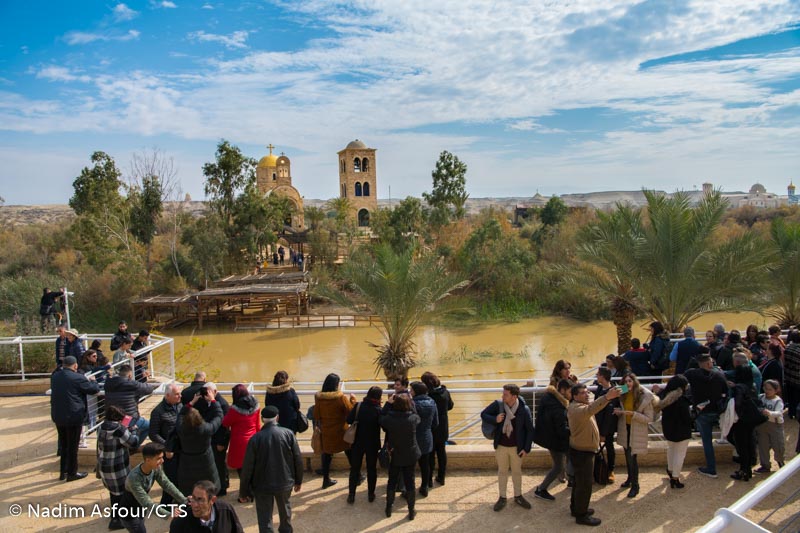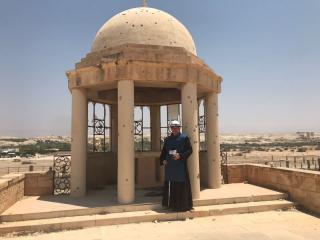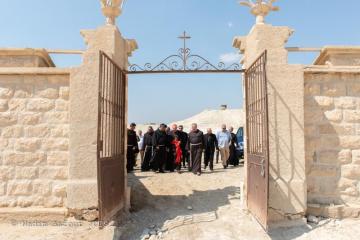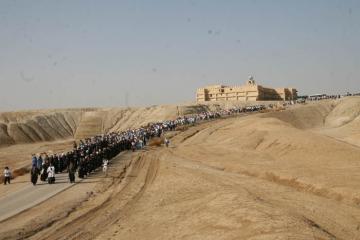A testimony on the importance of the site of the baptism of Jesus on the Jordan is handed down to us by the Anonymous Pilgrim of Piacenza already in the year 570. He speaks of a cross placed on a marble column in the center of the river, to indicate the event of Baptism .
According to historical memories, the Franciscans make the annual pilgrimage to this site at least since 1641.
Since 1967, as a result of the war between Israel and Jordan, the entire area was closed to pilgrims and tourists and became a huge minefield (55 hectares) and a military zone. It wasn’t until the year 2000 for the visit of Pope John Paul II in the Holy Land a small access was opened, which was then closed again after the first Intifada. In 2011, the Israeli authorities cleaned up a small part of the land to make it accessible to pilgrims.
Since January 2018, the Halo Trust organization has gradually de-mined all the territories belonging to the eight Christian churches, which own of the area: Catholic, Greek Orthodox, Armenian, Coptic, Ethiopian, Romanian, Syriac and Russian.
On July 9, 2018, it was the time for the Franciscan land to be de-mined. We proceeded with de-mining from the main road toward, around and inside the church. No suspicious material was found in the church and monastery, but the Halo Trust operators requested the removal of all objects.
(MORE INFO HERE: The Franciscan monastery on the Jordan River 50 years after the closure and Transforming a battlefield into a peace camp).
According to Halo Trust forecasts, 30,000 square meters of land will soon be declared free of landmines.
The Franciscan Church
In 1932, the Custody of the Holy Land purchased land near the place of Jesus’ baptism on the Jordan River and in 1933 it had a chapel built near the river. In 1935, a short distance away, the small church that still stands today, dedicated to St. John the Baptist, was opened.
The structure is on two levels. On the ground floor, there are the rooms of the monastery, used as a guesthouse and a place of support for the friars, who would return to the monastery in Jericho in the evenings (on which, in fact, that of the baptism site depends). Through the stairs placed outside the building, you can access the upper floor where there is the small church, with a dome and enclosed by windows.
The Franciscan building was restored after the 1956 earthquake, but, following the abandonment of the site during the Six Day War, it suffered further damage. It is not currently accessible to pilgrims, but work is underway to reopen this space again.
The Greek Orthodox Monastery
At a distance of one kilometer from the bank of the Jordan River, one can reach the imposing ruins of the Greek Orthodox Monastery of the Precursor (Pròdromos), or John the Baptist, with a crypt from the Byzantine era. In the Middle Ages, the Byzantine emperor Manuele Comneno (1143-1180) had the monastery rebuilt and fortified, but later it would have fallen again. In 1882 the Greek Orthodox Patriarchate bought the land and revived the religious community. The ancient Aramaic-Syriac name of the monastery, also preserved in Arabic: Mar Yuhanna, literally the Lord John (see the ancient Christian invocation Mar-ana tha, “Come, Lord!” in 1 Cor 16:22). In the Church of the Aramaic language, in fact, the title of lord / lady is still equivalent to that of saint / saint.
The monastic complex will soon be reopened. The announcement was made at the end of January 2018 by the Greek Orthodox Patriarchate of Jerusalem. In an official statement it is specified that the monastery is currently being renovated to become an Orthodox shrine and a place of welcome for pilgrims.





